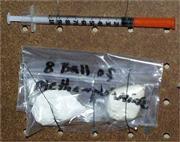Methamphetamine (Meth)
 What are the street names/slang terms for Methamphetamine?
What are the street names/slang terms for Methamphetamine?
Chalk, Crank, Croak, Crypto, Crystal, Fire, Glass, Meth, Tweek , White Cross.
What is Methamphetamine?
Methamphetamine (Meth) is an addictive stimulant that strongly activates certain systems in the brain.
What does it look like?
Meth is a crystal-like powdered substance that sometimes comes in large rock-like chunks. When the powder flakes off the rock, the shards look like glass, which is another nickname for meth. Meth is usually white or slightly yellow, depending on the purity.
How is it used?
Methamphetamine can be taken orally, injected, snorted, or smoked.
What are its short-term effects?
Immediately after smoking or injection, the user experiences an intense sensation, called a "rush" or "flash," that lasts only a few minutes and is described as extremely pleasurable. Snorting or swallowing meth produces euphoria - a high, but not a rush. After the initial "rush," there is typically a state of high agitation that in some individuals can lead to violent behavior. Other possible immediate effects include increased wakefulness and insomnia, decreased appetite, irritability/aggression, anxiety, nervousness, convulsions and heart attack.
What are its long-term effects?
Meth is addictive, and users can develop a tolerance quickly, needing larger amounts to get high. In some cases, users forego food and sleep and take more meth every few hours for days, 'binging' until they run out of the drug or become too disorganized to continue. Chronic use can cause paranoia, hallucinations, repetitive behavior (such as compuslively cleaning, grooming or disasembling and assembling objects), and delusions of parasites or insects crawling under the skin. Users can obsessively scratch their skin to get rid of these imagined insects. Long-term use, high dosages, or both can bring on full-blown toxic psychosis (often exhibited as violent, aggressive behavior). This violent, aggressive behavior is usually coupled with extreme paranoia. Meth can also cause strokes and death.
What is its federal classification?
Schedule II
Source
National Institute on Drug Abuse (NIDA); Drug Enforcement Administration (DEA)